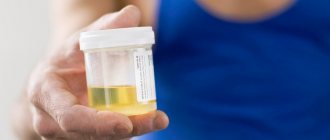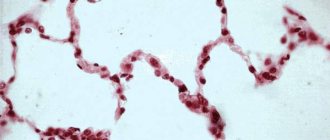Urine in a laboratory test provides the opportunity to obtain almost the same information as when studying a blood sample. At the same time, to collect it, it is not necessary to puncture the vein and skin, which suspicious patients often try to avoid.
During the analysis, quite a lot of parameters are determined, describing both the main characteristics and more specific ones that can indicate pathologies in the functioning of any particular system. For example, if the level of squamous epithelium in the urine is too high, then in most cases this is associated with various diseases of the urinary system. Although in certain situations its slight increase will not be calculated as a deviation.
Classification
Three types of epithelial cells can be found in urine:
- flat;
- transitional;
- renal.
Flat
The most common type of epithelium found in urine tests. Its cells line the urethra, and an excess of this value usually occurs with various types of inflammation of this organ (urethritis).
Flat epithelium
Transition
This epithelium lines the walls of the bladder, renal pelvis, and ureters. May be present in urine, but only in a single form. An increase in its content indicates dangerous diseases such as pyelonephritis, cystitis, and urolithiasis.
Stratified transitional epithelium
Renal
This epithelium lines the kidney tubules and should not be present at all in the urine of a healthy adult. However, it can be found in newborns - in quantities from one to five units, no more. An excess is considered an indication of an inflammatory process in the renal parenchyma.
Renal epithelium
If squamous epithelium is found in the urine, what does it mean?
If squamous epithelial cells are found in large quantities in urine during analysis, there may be several reasons for this phenomenon. But one way or another, all causes are usually associated with inflammatory pathologies in the body.
Next, we will consider the most common causes of the appearance of squamous epithelium in the urine.
- Cystitis . This pathology often occurs in both adults and children. Inflammation is caused by bacteria, viruses or fungi - and you should get rid of the disease only after an accurate diagnosis.
- Kidney problems . Various inflammatory diseases of the kidneys are a very likely cause of the appearance of squamous epithelium in the urine. The most common diseases in this case include: bilateral kidney damage;
- renal failure at various stages.
If an excess of the indicator is associated with inflammatory diseases of the genitourinary system, the following symptoms will most likely be present:
- decreased amount of urine and decreased frequency of urination;
- cloudy urine with a specific pungent odor;
- lower abdominal pain;
- painful urination with frequent urge;
- bloody spots in the urine.
The presence of squamous epithelium in the urine can sometimes mean inappropriate (excessive dosage) taking medications. And in men, this fact can mean inflammation of the prostate gland.
Important: if squamous epithelium is found in minimal quantities, this fact can be considered normal. Therefore, the presence of epithelial cells in the urine does not always mean illness.
Preparing for a smear test
If your doctor has prescribed you a urethral smear, you should follow some recommendations to ensure that the analysis is informative.
Avoid sexual intercourse 1-2 days before the examination. Hygiene of the external genitalia should be carried out in the evening before the examination. In the morning, on the day of the examination, there is no need to wash your genitals. Do not urinate 2-3 hours before visiting the doctor. One week before the test, stop taking any medications that you have not discussed with your doctor.
In some cases, before collecting material for a smear, the doctor may recommend massage of the prostate gland (through the rectum) or massage of the urethra with a special probe so that its secretion enters the urethra and, accordingly, participates in the analysis.
Normal squamous epithelium in urine
To find out whether a specific indicator of the content of epithelial cells in urine is normal, special tables have been created.
Sometimes it is necessary to slightly underestimate/overestimate the norms, based on the characteristics of a specific diagnosis and the patient’s age; however, in most cases, the indicators fall within the established norms.
Table
Normal epithelium in men
As for men, in this case squamous epithelium in the urine is undesirable in quantities of more than 5 units within the foreseeable limit of the microscope eyepiece.
Normal squamous epithelium in urine in women
When examining female biological material, it is necessary to make sure that no epithelial cells are noticed at all. Only single cells are allowed.
However, when a woman is expecting a child, the norms of epithelium in her urine can be increased to 5 units. As for children, the number of squamous epithelial cells in their urine should not be more than three units.
If a urine test shows the presence of squamous epithelium, then in most cases the number of cells is insignificant. If up to three cells are present, this is always considered the norm: for women, men, and children.
Norms of squamous epithelium in urine by age:
- for children in infancy, the norm is from 0 to 5 units, a pathological indicator is considered to be from 6 to 12 units;
- for a child in the first year of life, the norm is 0.3 units, pathology is 4-6 units;
- for a child from one to 18 years of age, the norm is 0.3 units, pathology is 4-10 units;
- for adults from 18 to 50 years old, the norm is 0-3 units, pathology - 4-10 units;
- after 50 years of age, the norm is 0-6 units, pathology - 7-12 units;
- for women during pregnancy, the norm is 0-6 units, pathology 7-12 units;
- during antibiotic treatment, the norm is 0-5 units, pathology is 6-12 units.
As can be seen from the table below, the norm of squamous epithelium for all patients is acceptable up to 5 units. As for other types - renal and transitional epithelium, ideally they should not be in the urine at all.
Click on the table to enlarge
What should I do if the flora smear in men is bad and what drugs are prescribed for treatment?
If the results of a smear from the urethra reveal a large amount of mucus, leukocytes, epithelium, bacteria, or at least one of these indicators is bad, you must definitely contact a specialist - a urologist, venereologist. You should not panic or try to treat yourself on the advice of friends and “medical doctors.” Losing time can lead to complications.
All known sexually transmitted infections can be successfully treated with special medications, which are divided into groups:
- broad-spectrum antibiotics - azithromycin, carfecillin, ofloxacin, cefpirone and others;
- broad-spectrum antibacterial drugs - metronidazole, efloran, trichopolum;
- antifungal agents - ketoconazole, pimafucin, nizoral and analogues;
- immune stimulants – galavit, polyoxidonium and others.
Local procedures are required - baths, instillations, suppositories with drugs. Treatment is always comprehensive and selected individually for each patient.
Important: despite the fact that many of the drugs are sold without a prescription, you should not take them without a doctor’s prescription, because you can not cure, but “heal” the disease, turning it into a chronic form.
What to do if there is increased squamous epithelium in the urine?
Squamous epithelial cells in urine
Excessive levels of squamous epithelium in urine almost always mean the presence of inflammatory disease of the kidneys or urinary tract.
Therefore, in most cases, discomfort occurs when urinating, and other negative symptoms appear.
If such alarming symptoms appear, you should definitely visit a doctor and get the necessary tests.
Treatment should be prescribed only by a doctor after a thorough examination, diagnosis of the biomaterial and the body as a whole.
Usually, if squamous epithelium is detected in the urine in quantities exceeding the norm, antibiotics are prescribed.
Treatment with antibiotics
The following drugs are often used:
Cefazolin
Azithromycin
Clarithromycin Ceftriaxone
In addition, it is necessary to take immunomodulators and vitamins, since most cases of this symptom are accompanied by reduced immunity and weakening of the body as a whole.
If inflammation of the bladder occurs, antibiotics are also used:
Levoflaxocin Ofloxacin Bactrim
Furadonin
In addition, non-steroidal anti-inflammatory medications are added:
Canephron
Cyston
Phytolysin
The standard course of treatment is 10 days. However, depending on the severity of the disease and the age of the patient, other important factors, the duration of the course can be changed by the attending physician in one direction or another.
If squamous epithelium appears in the urine as a result of chronic urethritis, local antiseptic therapy is necessary. In this case, the drugs are administered directly into the urethra using the drip method.
If the problem is due to renal nephropathy, you should stop taking medications that may cause this disease. However, only a doctor should prescribe or exclude any medications.
For renal nephropathy - and the disease is quite serious - treatment is carried out with the following drugs:
Triacinolone Prednisolone
For the period of treatment, a gentle diet is recommended, excluding fried and spicy foods. It is highly advisable to drink plenty of fluids, but with the exception of alcohol and coffee.
Physical therapy will also be useful - exercises should also be prescribed by a doctor. And simple home methods to strengthen the immune system will benefit not only the genitourinary system, but the entire body.
Attention: treatment will be most successful if squamous epithelium in the urine is detected as early as possible.
Video
What should I do?
To determine the level of epithelial cells, it is necessary to submit urine for a general analysis. After this, the results are addressed to a urologist or local physician or nephrologist. If a certain type of cells is elevated, they may prescribe an additional blood test for biochemical and general indicators, and conduct an ultrasound examination of the abdominal organs, kidneys and urinary tract.
Very often, this indicator can change in women during a period of hormonal imbalance, therefore, in the form of additional studies, blood donation is prescribed to check hormone levels.
At the first unpleasant symptoms in the form of pain in the abdomen or lower back, frequent urge to urinate, or change in the color of urine, you should immediately consult a doctor. After the results of a comprehensive examination, the doctor will select the correct treatment regimen. You should not self-medicate, as this can lead to severe complications.
Transitional epithelium in urine
The epithelium, called transitional, lines the mucous membrane of the following organs:
- renal pelvis;
- bladder;
- ureters;
- in men - prostate ducts (large);
- the upper portion of the urethra.
In principle, transitional epithelial cells should not be found in urine. Only rare single copies are allowed, maximum 3 units.
Transitional epithelium
If the norm is exceeded, we can talk about the following diseases:
- pyelonephritis;
- cystitis;
- kidney stone disease.
When is it prescribed and what can a flora smear diagnose in men?
The purpose of a flora smear is to identify the causative agents of sexually transmitted infections (STIs): gonorrhea, syphilis, chlamydia, gardnerellosis, trichomoniasis, genital herpes, human papillomavirus (HPV) and a number of other diseases.
Indications for taking a smear are:
- any discharge from the urinary canal - mucous, purulent, bloody;
- pain, burning sensation in the urethra;
- itching in the urinary canal, in the head area;
- frequent painful urination;
- redness of the skin, the presence of a rash, ulcers on the genitals.
Also, any man can take a smear test if he is suspected of contracting a sexually transmitted infection as a result of questionable sexual contact. In addition, a smear is taken during a routine examination by a urologist. The goal is to identify hidden infections that may be asymptomatic in a man, but he is the source of infection.
Renal epithelium in urine
According to medical standards, renal epithelium should, in principle, be absent in urine. If cells are still found, this may indicate the development of kidney diseases such as:
- damage to the parenchyma;
- pyelonephritis;
- glomerulonephritis, etc.
Note that glomerulonephritis develops slowly and may not manifest itself for many years. And it is possible to detect renal epithelium in the urine, indicating this disease, only when the disease is already severely expressed.
The following symptoms are likely to occur with this pathology:
- dark and foamy urine;
- swelling of the extremities (especially legs);
- arterial hypertension;
- pain in the kidney area.
- Often the norms of renal epithelium in the urine are exceeded after kidney transplant operations, and if the excess is significant, we can talk about rejection of the transplanted organ by the patient's body.
- And sometimes the presence of renal epithelium in the urine can be evidence of such a serious disease as diabetes mellitus - with ischemic kidney damage associated with this disease.
- A problem also arises in the case of poisoning or intoxication of the body.
Renal epithelium in urine
In addition to the above, the renal type of epithelium can be found in urine with congenital anomalies in the structure of the excretory organs. But in this case, the problem is diagnosed immediately after the birth of the child, and it cannot arise out of the blue during life.
Excess of squamous epithelium in urine during pregnancy
While expecting a child, a woman may well have squamous epithelium in her urine - and in most cases this fact is the norm (if it does not exceed 5 units).
The fact is that during pregnancy the genitourinary organs work in an enhanced mode, so frequent urination against the background of active exfoliation of the epithelial mucous layer is common.
In addition, the growing uterus compresses the genitourinary organs, displacing them, which also leads to more active desquamation of the epithelium.
The normal level of squamous epithelium during pregnancy is no more than 5 units
If the level of epithelium in the urine is more than 5 units, the woman is then under medical supervision: it is important to protect the health of the patient herself, and also not to forget about the health of the fetus.
Flat epithelium in the urine of a child
Cells of desquamated epithelium are sometimes found even in the urine of newborn babies. And this is considered quite normal, since when a child is born, the child’s body adapts to new conditions.
Attention: in almost all healthy newborns in the first two weeks of life, the level of epithelium in the urine is twice as high.
Analysis for squamous epithelium in a child.
The norm is no more than 3 units. On average, the presence of epithelium in a child’s urine should not exceed three units - and this is the norm for children of any age.
If the amount is exceeded, this may indicate the same problems with the kidneys and genitourinary organs as in adults.
A sharp excess of this indicator is especially dangerous for a child.
The most common causes of an excess of epithelial cells in the urine of children are the following diseases:
- inflammatory pathologies - cystitis and urethritis;
- inflammatory processes in the genital organs;
- kidney diseases;
- slow blood circulation in the pelvis;
- urolithiasis disease;
- neurological diseases accompanying urinary retention;
- reflux of urine (reverse movement);
- spasmodic pathologies of the genitourinary organs;
- salt deposits;
- purulent inflammatory processes, poisoning, intoxication.
Factors provocateurs
The appearance of an increased amount of epithelium in children does not happen out of nowhere.
The following factors provoke this phenomenon.
- Genetic. Occurs if one of the parents (usually the mother) suffered from similar genitourinary ailments.
- A pathologically passing, complicated pregnancy is also one of the powerful negative factors.
- If a child was born premature, this significantly increases the risk of various pathologies, including those associated with the kidneys and genitourinary system.
- With asphyxia (suffocation by the umbilical cord) during childbirth, the child is born with poor health, which also provokes various abnormalities.
- Developmental defects, especially congenital ones, greatly influence the occurrence of health problems throughout the body.
In addition to the above, infections that the child has suffered or that have not been treated can provoke the appearance of an increased amount of epithelium in the urine:
- furunculosis;
- angina;
- tonsillitis, etc.
Sometimes (and in the best case), an excess level of epithelium in children is observed due to incorrect, not very thorough preparation for the test: lack of disinfection of the container, hygiene of the genitals.
How can men prepare for a urethral smear?
In order for the analysis to be carried out efficiently, and there is no need to retake it, you should adhere to the following rules a couple of days before taking the analysis:
- Avoid fatty and spicy foods.
- Do not drink alcoholic or carbonated drinks.
- Do not take medications.
- Do not engage in intimate relationships.
✚ Worth remembering. Before taking a smear, you must avoid fatty foods, alcohol, and carbonated water.
So, antibiotics are able to destroy microflora and bacteria. As for alcohol and spicy foods, they affect kidney function, the volume and rate of urine division, as well as the presence of proteins and salts.
If it is vital for a man to take some kind of medication, then before taking tests he should consult with a specialist on this matter.
On the day of the test, you should not shower; you can simply wipe your genitals with a cloth soaked in water. Before the procedure (in the examination room), the penis is wiped with alcohol to prevent microbes and epithelium from entering the scraping.
Urinalysis to detect squamous epithelium
To determine the content of squamous epithelium, you will have to undergo a general urine test. It is necessary to approach this procedure competently and knowledgeably - the reliability of the analyzes is extremely important.
A general urine test for squamous epithelium should be taken in the morning and on an empty stomach.
The first step is to purchase a urine container. You should not use baby food jars and other household containers: even thoroughly washed and boiled, these containers can retain harmful microorganisms on their surface.
We advise you to purchase a special container at the pharmacy: this container is already properly sterilized and completely sealed. The cost is on average 100-200 Russian rubles.
- Two days before the donation procedure, you should not take diuretic medications, as well as medications containing nitrofuran compounds. It is highly undesirable to consume foods with coloring properties the day before testing: beets, citrus fruits, carrots.
- Before collecting urine, it is necessary to carry out hygienic procedures so that particles of mucus and fluid from the external genitalia do not get into the container. Women are advised to use a tampon to block vaginal discharge. And if a woman is menstruating, it is generally better not to donate urine during this period. The likelihood of the presence of excess impurities is too high.
- You need to collect urine immediately before you donate it, that is, usually in the morning. You should not carry out this procedure in the evening, since by the morning the biomaterial will no longer be fresh, and the results of the study will not be able to fully reflect the actual state of affairs. It is optimal to transfer the container to the laboratory no later than an hour or two after collecting the biomaterial.
Attention: there is no need to strain a whole jar/container of urine for analysis. The optimal amount is 100 ml, which is about half a glass.
Modern pharmacology can offer an independent method of examining urine. In pharmacies you can find express strips for sale, with which you can easily and quickly do a general urine test at home.
But in any case, only a doctor should make a diagnosis and prescribe treatment.
Diagnostic features
Determining which epithelium is present in urine and in what quantity is not an easy task, and requires attention, perseverance, certain knowledge, and experience from the laboratory assistant. And if previously cell counting was done “manually”, now there are instruments and programs that allow analysis to be done without any human intervention at all. This significantly improves the accuracy of the results.
If the indicator is significantly exceeded, a repeat analysis is usually prescribed before making a final diagnosis. The fact is that the first result sometimes turns out to be incorrect due to the patient’s failure to comply with hygiene rules.
So, the content of squamous epithelium in urine should not exceed 3-5 units at any age and condition - the norm applies to both men and women. If the analysis shows that this indicator is exceeded, it is necessary, under the guidance of a doctor, to identify the cause and carry out a course of treatment.
The sooner the excess is established and, accordingly, the diagnosis is made, the greater the chances for a speedy and successful recovery.
Rules for collecting urine for analysis
There are certain rules that must be followed when collecting fluid for analysis. This is due not so much to the convenience of the patient, but to the importance of obtaining the required starting material without impurities, which will guarantee an accurate result.
More on the topic: Why does the urine turn dark?
Sequence of actions for collecting urine:
| № | Helpful information |
| 1 | one day before collecting fluid for analysis, you must stop taking foods that can color the secreted fluid. These include beets, carrots, and all types of citrus fruits. It is necessary to exclude spices and salt from the diet, and not to take diuretics. As part of drug treatment, you need to stop taking nitrofuran drugs for a day, which color urine bright yellow. |
| 2 | Immediately before collection, you need to carry out thorough hygiene of the genitals, possibly without using chemicals. It will be enough just to wash with clean water |
| 3 | urine is collected in a volume of 100 ml in the morning on an empty stomach. The container used is plastic or glass, it must be clean, it is better to sterilize in boiling water or use containers from a pharmacy |
| 4 | the collected analysis must be delivered to the laboratory or clinic as soon as possible, since bacteria may form when stored in a warm place for more than 2 hours |
| 5 | Women during menstruation should avoid taking tests to avoid bloody discharge in the fluid, which will be perceived by research doctors as a symptom of the disease. If the need is urgent, you should use a tampon |










